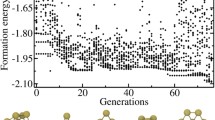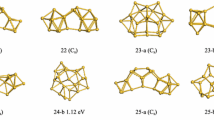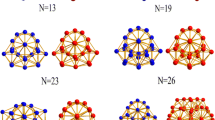Abstract
The Lennard–Jones–Gauss (LJG) pair potential has been shown to model structures with diverse symmetric and topological characteristics. This extension of the well-studied Lennard–Jones potential introduces competing length scales for the energy interaction minimum, i.e., there are two distances at which atoms can be apart where they are energetically stable. Here, we report the low-energy configurations of Lennard–Jones–Gauss nanoclusters for a wide range of potential parameters and numbers of particles using a genetic algorithm. We also analyze the structural characteristics of those clusters to understand how they develop with respect to the two competing length scales. We have shown that desirable characteristics for energetic, optical and catalytic applications, such as being hollow or chiral, occur more frequently in specific parameter regions. This gives us insight both into materials design and lays the groundwork for further study into both the LJG potential and the clusters it models.
Graphical abstract










Similar content being viewed by others
Data Availability Statement
A full list of the data for the predicted LJG clusters can be found in the supplemental information and includes their energy, point group and whether or not the cluster is caged.
References
M. Engel, H.-R. Trebin, Self-assembly of monatomic complex crystals and quasicrystals with a double-well interaction potential. Phys. Rev. Lett. 98, 225505 (2007)
M. Engel, H.-R. Trebin, Stability of the decagonal quasicrystal in the Lennard-Jones-Gauss system. Phil. Mag. 88, 1959 (2008)
D.J. Wales, J.P. Doye, Global optimization by basin-hopping and the lowest energy structures of Lennard-Jones clusters containing up to 110 atoms. J. Phys. Chem. A 101, 5111 (1997)
W. Kohn, A.D. Becke, R.G. Parr, Density functional theory of electronic structure. J. Phys. Chem. 100, 12974 (1996)
A. Li, H.S. Muddana, M.K. Gilson, Quantum mechanical calculation of noncovalent interactions: a large-scale evaluation of PMx, DFT, and SAPT approaches. J. Chem. Theory Comput. 10, 1563 (2014)
M. Zu, P. Tan, N. Xu, Forming quasicrystals by monodisperse soft core particles. Nat. Commun. 8, 1 (2017)
F. Baletto, R. Ferrando, Structural properties of nanoclusters: energetic, thermodynamic, and kinetic effects. Rev. Mod. Phys. 77, 371 (2005)
R. Pal, A. Poddar, P. K. Chattaraj, Atomic clusters: structure, reactivity, bonding, and dynamics. Front. Chem. 9 (2021)
L. Liu, A. Corma, Metal catalysts for heterogeneous catalysis: from single atoms to nanoclusters and nanoparticles. Chem. Rev. 118, 4981 (2018)
S. L. Fereja, W. Chen, Metal nanoclusters for energy storage applications, in Luminescent Metal Nanoclusters (Elsevier, 2022) pp. 625–658
K.M. Mayer, J.H. Hafner, Localized surface plasmon resonance sensors. Chem. Rev. 111, 3828 (2011)
K.N. Dinh, Q. Liang, C.-F. Du, J. Zhao, A.I.Y. Tok, H. Mao, Q. Yan, Nanostructured metallic transition metal carbides, nitrides, phosphides, and borides for energy storage and conversion. Nano Today 25, 99 (2019)
M.A. Mahmoud, D. O’Neil, M.A. El-Sayed, Hollow and solid metallic nanoparticles in sensing and in nanocatalysis. Chem. Mater. 26, 44 (2014)
K.Y. Bliokh, F. Nori, Characterizing optical chirality. Phys. Rev. A 83, 021803 (2011)
Y. Zhu, J. Guo, X. Qiu, S. Zhao, Z. Tang, Optical activity of chiral metal nanoclusters. Accounts Mater. Res. 2, 21 (2020)
B. Zhao, S. Yang, J. Deng, K. Pan, Chiral graphene hybrid materials: structures, properties, and chiral applications. Adv. Sci. 8, 2003681 (2021)
D.J. Wales, Exploring energy landscapes. Annu. Rev. Phys. Chem. 69, 401 (2018)
N. Chakraborti, Genetic algorithms in materials design and processing. Int. Mater. Rev. 49, 246 (2004)
K. Gallagher, M. Sambridge, G. Drijkoningen, Genetic algorithms: an evolution from Monte Carlo Methods for strongly non-linear geophysical optimization problems. Geophys. Res. Lett. 18, 2177 (1991)
S. Fredericks, K. Parrish, D. Sayre, Q. Zhu, PyXtal: a Python library for crystal structure generation and symmetry analysis. Comput. Phys. Commun. 261, 107810 (2021)
C.R. Harris, K.J. Millman, S.J. Van Der Walt, R. Gommers, P. Virtanen, D. Cournapeau, E. Wieser, J. Taylor, S. Berg, N.J. Smith et al., Array programming with NumPy. Nature 585, 357 (2020)
J. W. Ochterski, Vibrational Analysis in Gaussian, help@gaussian.com (1999)
A.H. Larsen, J.J. Mortensen, J. Blomqvist, I.E. Castelli, R. Christensen, M. Dułak, J. Friis, M.N. Groves, B. Hammer, C. Hargus et al., The atomic simulation environment-a Python library for working with atoms. J. Phys.: Condens. Matter 29, 273002 (2017)
Acknowledgements
The work was supported by the Grant DE-SC0021375 funded by the U.S. Department of Energy, Office of Science. We also acknowledge the computational resources awarded by XSEDE, a project supported by the National Science Foundation grant number ACI-1053575. The authors also acknowledge the support from the Texas Advances Computer Center (with the Stampede2 and Bridges supercomputers). We also acknowledge the Super Computing System (Thorny Flat) at WVU, which is funded in part by the National Science Foundation (NSF) Major Research Instrumentation Program (MRI) Award #1726534, and West Virginia University.
Author information
Authors and Affiliations
Contributions
The algorithm used for predicted LJG clusters was written by Nathaniel Wesnak and Dr. Aldo H. Romero. The data collection for this study was done by Nathaniel Wesnak. This paper was written and edited by Nathaniel Wesnak, Dr. Aldo H. Romero and Dr. Soumya S. Bhat.
Corresponding author
Supplementary Information
Below is the link to the electronic supplementary material.
Rights and permissions
Springer Nature or its licensor (e.g. a society or other partner) holds exclusive rights to this article under a publishing agreement with the author(s) or other rightsholder(s); author self-archiving of the accepted manuscript version of this article is solely governed by the terms of such publishing agreement and applicable law.
About this article
Cite this article
Wesnak, N., Bhat, S.S. & Romero, A.H. Structural exploration of low-energy Lennard–Jones–Gauss clusters with a genetic algorithm. Eur. Phys. J. B 96, 154 (2023). https://doi.org/10.1140/epjb/s10051-023-00611-1
Received:
Accepted:
Published:
DOI: https://doi.org/10.1140/epjb/s10051-023-00611-1




